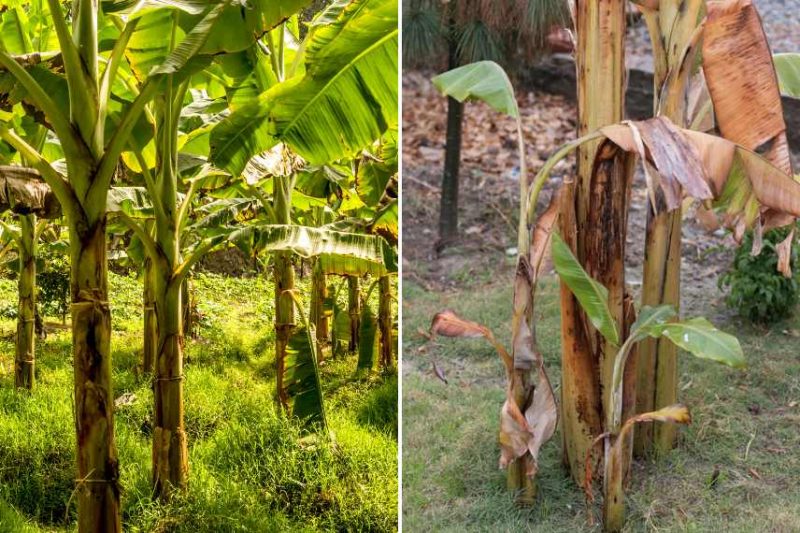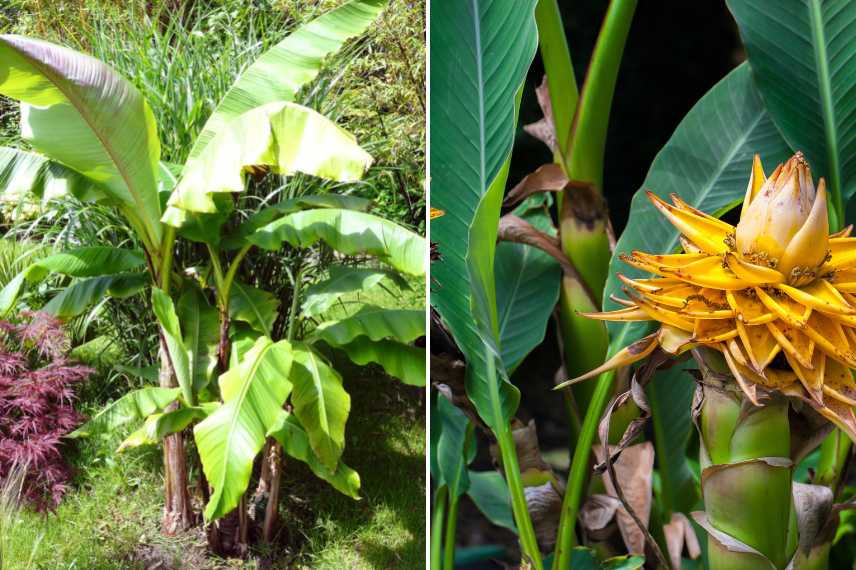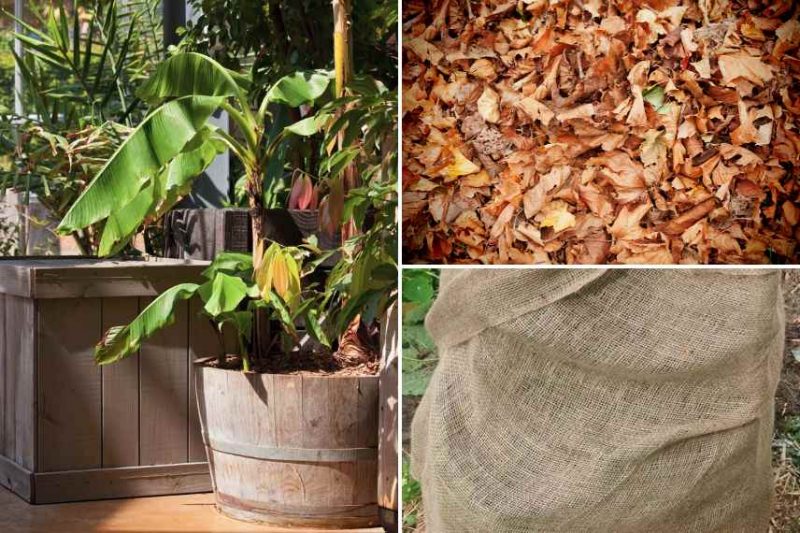The banana plant is a very frost‑tender tropical plant often grown in a pot on a terrace or indoors. If there are hardy varieties, such as Musa basjoo well suited to planting outdoors in the ground in mild regions, most banana plants are sensitive to cold. Depending on your climate, they need special attention when winter approaches. Discover all our tips to protect your banana plant from the cold, whether you grow it in a pot or in the ground!
And, to learn everything about banana plants and how to grow them, see our plant sheet: “Banana plant: planting, cultivation and care, in pot or in garden”

Why protecting banana plants in winter?
Native to tropical to subtropical, mild and humid climates, the banana plant is an exotic plant that is usually frost‑tender in our latitudes. It struggles with temperatures below 8°C and prefers warm, humid atmospheres. Some are killed by frost from 0°C. Except in our mildest areas, such as the Atlantic coast or the coastal Mediterranean zone, they are generally grown in a conservatory, under glass, or as houseplants, at temperatures that remain above 10°C.
- Among the most frost‑tender is the Abyssinian red banana, which can only be grown in the ground in the mildest regions, in sheltered positions, in Zone 10a (-1.1°C to +1.7°C), and the pink‑flowered banana (Musa velutina) hardy down to about -5/-8°C.
- Among the hardiest, is Musa basjoo, the species most resistant to our cold, wet winters, able to withstand severe (but short) frosts down to -12/-15°C. There are also other fairly cold‑resistant species, such as Musella lasiocarpa (down to around -10°C).
→ to read for more information: “Hardy plants and hardiness”

Protecting a banana plant planted in the ground
When to protect it?
Before frost arrives! In cooler regions, it is best to watch the thermometer once the growing season ends. As soon as light overnight frosts appear, it's time to act. In any case, if frosts of around -8°C or lower are forecast, it is essential to protect it from the cold to help preserve its aerial parts. It is often weakened as soon as temperatures fall below freezing. In the mildest areas where the banana plant can be grown in the ground, protection is rarely necessary, except for the most frost‑tender species.
How to protect it?
- In late autumn, cut back the lowest leaves to ground level
- Protect the stump with a wire cage at least 50 cm high (leave 20 cm between trunk and cage to allow air circulation and avoid mould), and fill the cage with dead leaves or straw to insulate the stipe from the cold
- Cover with the cut leaves from your banana plant
- Spread a thick layer of well‑dried organic mulch (dead leaves, straw, wood chip…) at least 30 cm deep all around the base of the banana plant
- Wrap only the aerial parts with a winter fleece to avoid excess humidity; ensure water does not pool inside the protection
- Remember to aerate regularly on sunny days
- Remove these protections once frosts are no longer expected
Good to know: Marielle from La Fargeseraie, a jungle garden near Saint‑Etienne in France, has a very particular technique. In her town garden, which experiences harsh winters, she grows Ensete ventricosum 'Maurelii' (Abyssinian red bananas), which are relatively frost‑tender (-4 to -6°C approx.) and cannot remain in the ground in her garden without suffering damage and have a tendency to rot under protections. Because the root system of these banana plants is poorly developed, she lifts her banana plants out of the ground for the winter! Her method is a little tedious, especially if they are several metres high, but it allows them to be kept in good condition from one year to the next:

- Cut the low leaves
- Dig up your banana plants and remove the bulk of the soil from the roots
- Prune the top of the crown with a handsaw
- Turn your banana plants upside down so they drain of water (for 24 hours)
- Store them in the cellar or any cool, dark space in a large pot filled with potting compost, without watering
- Take them out again after the frosts in late March–early April and replant in full sun or partial shade, in a rich, rather cool but well‑drained soil
Other tip: grow your banana plant in a large ventilated pot (or one with holes large enough to let roots pass) which you bury for the warmer months so you can lift it in autumn to overwinter it more easily frost‑free.
Overwintering a banana plant in a pot
When to bring the pot inside?
In regions with harsh winters, you can leave it outdoors from late May to September. In areas with mild winters, pots can be kept outside if protected, since potted plants are more sensitive to cold due to greater exposure. Everywhere else, bring the pot indoors before the first frosts. The banana plant in a pot must be protected as soon as night‑time temperatures fall below 8°C. You can put the pot back outside in spring from April–May depending on the region, when frosts are no longer a risk and temperatures are mild.
Where and how to overwinter it?
If you keep the pot outdoors:
I still recommend giving it minimal protection. For this there are two options:
- Keep your banana plants against a south‑facing wall, sheltered from winter rain
- Wrap the pseudostem in its large leaves, tying them so they form a protective padded layer against frost
- Place a jute cloth or bubble wrap around the container to protect it during freezing nights
Or,
- Wrap everything with a winter fleece, fastening it securely around the base of the trunk to insulate it from the cold. Ventilate regularly by opening the fleece on days when there is no frost.
In both cases, spread a thick layer of straw or dead leaves at the base of the banana plant. Reduce watering, while ensuring the roots never dry out. Remove these protections in spring.
If you keep it indoors:
Store it in a conservatory or heated greenhouse, ideally at 15°C in winter. Make sure the air is not too dry. Mist the foliage regularly in winter to counter indoor dryness. Water once a week. Banana plants are easy to grow indoors if temperatures remain above 10°C.
































![[plant name="Banana plant" action="overwinter"] wintering a banana tree](https://en.promessedefleurs.eu/blogwp/wp-content/uploads/2022/12/hiverner-un-bananier.jpg)
Comments